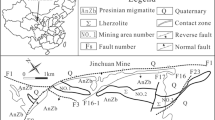Abstract
In this article, we study numerically the effect of anthropogenic and natural activities such as vehicular motion, blasting, rainfall, seismic activities etc. on time of failure of a rock slope using the rate, state, temperature and pore pressure friction (RSTPF) model proposed by Sinha et al. [6]. The initial creep velocity, gravitational stress and pore pressure are varied to investigate their effects on time of failure of the rock slope. It is observed that time of failure decreases with an increase in creep velocity, gravitational stress and pore pressure. The mechanism for these observations is also elucidated.
Access this chapter
Tax calculation will be finalised at checkout
Purchases are for personal use only
Similar content being viewed by others
References
Willie DC, Mah CW (2004) Rock slope engineering, 4rd edn. Spon Press
Handwerger AL, Rempel AW, Skarbek RM, Roering JJ, Hilley EG (2016) Rate-weakening friction characterizes both slow sliding and catastrophic failure of landslides. Proc Nat Acad Sci 113(37):10281–10286
Chau KT (1995) Landslides modeled as bifurcations of cree** slopes with nonlinear friction law. Int J Solids Struct 32(23):3451–3464
Singh AK, Kainthola A, Singh TN (2012) Prediction of factor of safety of a slope with an advanced friction model. Int J Rock Mech Min Sci 1997(55):164–167
Singh AK, Singh TN (2016) Stability of the rate, state and temperature friction model and its applications. Geophys J Int 205:636–647
Sinha N, Singh AK, Singh TN (2019) Dynamic stability of the rate, state, temperature, and pore pressure friction model at a rock interface. Pure Appl Geophys 176(11):4969–4982
Eberhardt E, Stead D, Coggan JS (2004) Numerical analysis of initiation and progressive failure in natural rock slopes-the 1991 Randa rockslide. Int J Rock Mech Min Sci 41:69–87
Faillettaz J, Sornette D, Funk M (2010) Gravity-driven instabilities: Interplay between state- and velocity-dependent frictional sliding and stress corrosion damage cracking. J Geophys Res 115:B03409. https://doi.org/10.1029/2009JB006512
Goren L, Aharonov E (2007) Long runout landslides: the role of frictional heating and hydraulic diffusivity. Geophys Res Lett 34:L07301. https://doi.org/10.1029/2006GL028895
Helmstetter A, Sornette D, Grassol J-R, Andersen JV, Gluzman S, Pisarenko V (2004) Slider-block friction model for landslides: application to vaiont and la clapière landslides. J Geophys Res 109:B202409
Chester FM, Higgs NG (1992) Multimechanism friction constitutive model for ultrafine quartz gouge at hypocentral conditions. J Geophys Res 97(B2):1859–1870
Chester FM (1994) Effects of temperature on friction: constitutive equations and experiments with quartz gauge. J Geophys Res 99(B4):7247–7261
Lachenbruch AH (1980) Frictional heating, fluid pressure, and the resistance to fault motion. J Geophys Res 85:6097–6112
Lorenzo SD, Loddo M (2010) Effect of frictional heating and thermal advection on pre-seismic sliding: a numerical simulation using a rate-, state- and temperature-dependent friction law. J Geodyn 49:1–13
Veveakis E, Vardoulakis I, Di TG (2007) Thermoporomechanics of cree** landslides: the 1963 Vaiont slide, Northern Italy. J Geophys Res 112:F03026
Segall P, Rice JR (1995) Dilatancy, compaction and slip instability of a fluid-infiltrated fault. J Geophys Res 100(B11):22155–22171
Segall P, Rice JR (2006) Does shear heating of pore fluid contribute to earthquake nucleation? J Geophys Res 111:B09316. https://doi.org/10.1029/2005JB004129
Davis RO, Smith NR, Salt G (1990) Pore fluid frictional heating and stability of cree** landslides. Int J Numer Anal Meth Geomech 14:427–443
Mase CW, Smith L (1987) Effects of frictional heating on the thermal, hydrologic, and mechanical response of a fault. J Geophys Res 92:6249–6272
Ruina AL (1983) Slip instability and state variable friction law. J Geophys Res 88(B12):10359–10370
Marone C (1998) Laboratory derived friction laws and their application to seismic faulting. Ann Rev Earth Planet Sci 26:643–696
Rice JR (2006) Heating and weakening of faults during earthquake slip. J Geophys Res 111:B05311. https://doi.org/10.1029/2005JB004006
Acknowledgements
This work is supported by NRDMS-DST (order No. NRDMS//02/43/016(G)) Government of India.
Author information
Authors and Affiliations
Editor information
Editors and Affiliations
Rights and permissions
Copyright information
© 2022 The Author(s), under exclusive license to Springer Nature Singapore Pte Ltd.
About this paper
Cite this paper
Sinha, N., Singh, A.K., Vasudeo, A.D. (2022). Effect of Anthropogenic and Natural Activities on a Rock Slope Failure Using Rate, State, Temperature and Pore Pressure Friction. In: Laishram, B., Tawalare, A. (eds) Recent Advancements in Civil Engineering. ACE 2020. Lecture Notes in Civil Engineering, vol 172. Springer, Singapore. https://doi.org/10.1007/978-981-16-4396-5_47
Download citation
DOI: https://doi.org/10.1007/978-981-16-4396-5_47
Published:
Publisher Name: Springer, Singapore
Print ISBN: 978-981-16-4395-8
Online ISBN: 978-981-16-4396-5
eBook Packages: EngineeringEngineering (R0)




